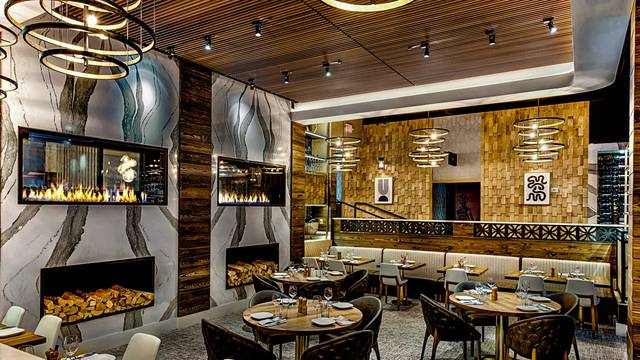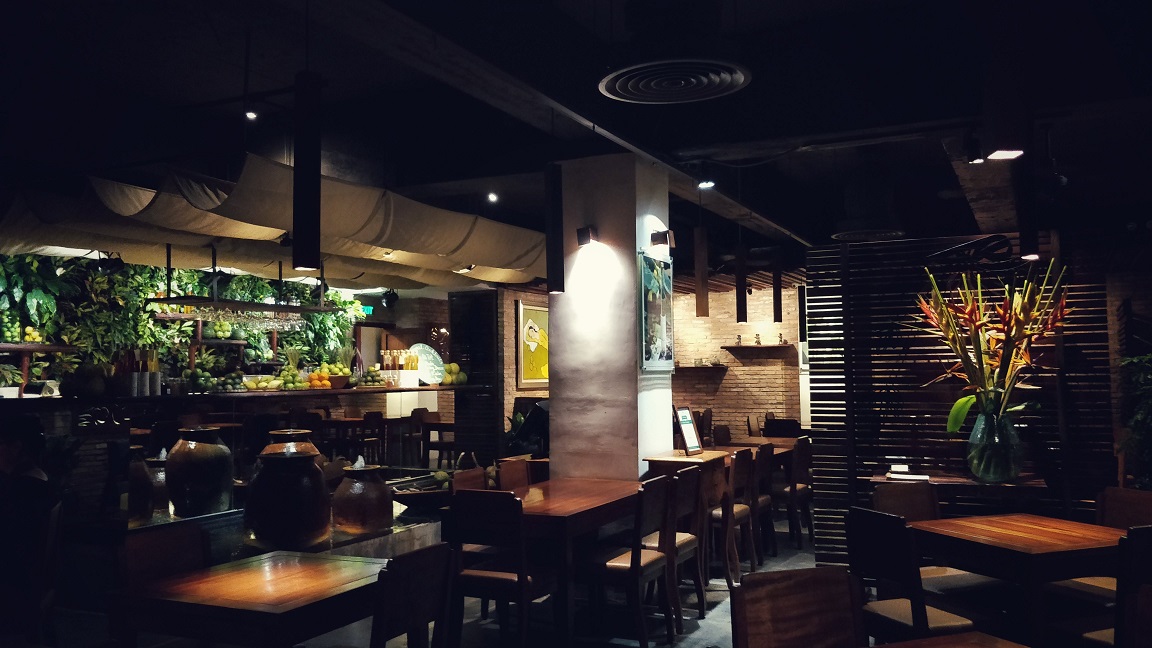Romantic Restaurants Islamabad: Perfect Dining Destinations for Couples
Romantic Restaurants Islamabad: Perfect Dining Destinations for Couples
Blog Article
Savor Authentic Oriental Food With a Pan-Asian Twist for a Culinary Experience
Starting a cooking journey with genuine Oriental cuisine, boosted with a Pan-Asian twist, offers an unique possibility to check out the abundant tapestry of tastes that define the area's varied culinary traditions. This experience welcomes you to savor the charming balance of tastes-- pleasant, salted, spicy, and sour-- harmonized by aromatic herbs and spices. Visualize the cutting-edge combination of Thai curry and ramen or the unforeseen pleasure of sushi burritos. As you ponder these luring dishes, take into consideration the social narratives and historic influences that form them, each bite providing a story waiting to be uncovered.

Discovering Pan-Asian Flavors
In the world of global gastronomy, Pan-Asian cuisine stands out for its exceptional diversity and the harmonious interplay of flavors from numerous Asian cultures. This culinary technique commemorates the distinct ingredients and rich traditions discovered throughout the continent, creating a tapestry of preferences that is both enjoyable and intriguing. Secret to Pan-Asian food is its capacity to stabilize contrasting flavors-- sweet, salty, spicy, and sour-- while highlighting the freshness and quality of each active ingredient.
From the umami-rich soy sauce of Japan to the intense chili peppers of Thailand, Pan-Asian food supplies a comprehensive scheme of flavors. These elements are frequently integrated in innovative ways, enhancing dishes with layers of complexity. For instance, making use of aromatic herbs such as lemongrass and cilantro, common in Vietnamese and Thai cuisine, includes a refreshing brightness to dishes, while the incorporation of coconut milk delivers a creamy, rich appearance.
The focus on fresh produce and aromatic spices guarantees that each meal is not just a banquet for the taste buds however likewise for the senses. Pan-Asian food invites diners to start a cooking journey, exploring the vast and varied landscapes of Oriental gastronomy with every bite.
Combination Dishes to Attempt
While Pan-Asian cuisine is celebrated for its typical flavors, the contemporary cooking landscape is increasingly accepting blend dishes that blend these traditional aspects with impacts from other regions. This ingenious method not only honors the rich heritage of Asian cooking arts yet likewise introduces novel taste experiences that appeal to modern tastes buds.
An archetype of such a combination recipe is the Korean-Mexican taco, where marinated bulgogi beef is wrapped in a cozy tortilla, covered with kimchi and a hot gochujang-infused salsa. This mix weds the vibrant, tasty flavors of Korea with the vibrant, fresh aspects of Mexican food. In a similar way, sushi burritos have actually gotten popularity, amalgamating the delicate artistry of Japanese sushi with the hearty, hand-held benefit of a burrito, usually featuring fusion components like tempura shrimp and avocado with a drizzle of wasabi mayo.
One more notable meal is Thai curry ramen, which infuses the creamy, aromatic spices of Thai curry right into the comforting broth of traditional Japanese ramen, creating a harmonious blend that tantalizes the detects. These blend recipes expand beyond plain uniqueness; they stand for a culinary dialogue between cultures, encouraging expedition and innovation in the globe of Pan-Asian cuisine.
Important Components and Spices
To truly value Pan-Asian food, one should understand the essential active ingredients and spices that form its structure. This diverse cooking design draws from an abundant tapestry of Oriental traditions, using an unified mix of appearances and flavors. Secret active ingredients include soy sauce, fish sauce, and oyster sauce, which present a savory umami deepness crucial to Eastern meals. Complementary to these are rice vinegar and mirin, offering a delicate acidity and sweet taste.
Aromatic components are crucial, with ginger, lemongrass, and garlic being common across different Pan-Asian recipes. These active ingredients offer a great smelling base that enhances the complexity of tastes. Flavors such as celebrity anise, cardamom, and cinnamon introduce warmth and personality, echoing impacts from regions like China and India.

Food Preparation Methods and Tips
Mastering the art of Pan-Asian cuisine needs experience with its distinctive food preparation techniques, each adding to the dynamic tapestry of flavors this culinary tradition is celebrated for. Central to these techniques is the stir-fry, a fast cooking technique that preserves the nutritional stability and brilliant colors of components. Using a wok, the stir-fry approach permits also heat distribution, vital for attaining the characteristic texture and taste equilibrium of Pan-Asian meals.
One more essential technique is steaming, particularly prevalent in Chinese food. This mild approach preserves the natural tastes and nutrients of components, making it optimal for seafood and veggies. Dumplings, a beloved staple, often benefit from steaming, causing soft, delicious structures.
Barbecuing, additionally important, gives smoky midsts to meals such as Oriental bulgogi or Japanese yakitori (asian restaurant isb). This technique commonly includes seasoning components, permitting tastes to permeate deeply before cooking over an open fire or hot plate
Finally, grasping the art of balancing tastes-- sweet, sour, salty, bitter, and umami-- is important. Effectively layering these aspects can elevate a dish from common to remarkable, offering a facility and satisfying culinary experience that symbolizes the significance of Pan-Asian cuisine.
Eating Experiences Worldwide
Throughout the globe, Pan-Asian food provides an unequaled eating experience, celebrated for its rich tapestry of tastes and dynamic discussions. This cooking phenomenon has gone beyond cultural limits, recording the hearts and palates of food lovers worldwide. In multicultural cities like New York, London, and Sydney, Pan-Asian dining establishments function as fusions where cooking practices from Thailand, Japan, China, and past assemble, supplying restaurants with a diverse mix of dishes that highlight the region's variety.
The global appeal of Pan-Asian cuisine depends on its capability to provide both authenticity and development. Chefs masterfully wed conventional ingredients such as lemongrass, soy sauce, and miso with contemporary strategies, causing dishes that are both refreshingly new and familiar. This fusion enables diners to start a cooking journey that respects heritage while accepting modernity.
Additionally, dining experiences are elevated via thoughtfully designed environments that mirror the values of Pan-Asian aesthetic appeals. From minimalist Japanese-inspired insides to vibrant Thai-themed rooms, each dining establishment uses a special ambiance that matches the cooking offerings. Therefore, clients are not simply consuming a meal but partaking in a social experience, making Pan-Asian eating a really international sensation.
Final Thought
The exploration of Pan-Asian cuisine supplies a profound understanding of the intricate interaction of flavors and culinary traditions across Asia. By embracing blend dishes such as Thai curry ramen and sushi burritos, the cooking journey not just highlights the flexibility of typical components yet likewise showcases innovative modern-day methods. This gastronomic journey, enhanced by cooking methods and crucial spices, supplies a distinct possibility to appreciate the multiculturalism and cooking artistry that define Pan-Asian food on a worldwide range.
Embarking on a cooking trip through authentic Asian food, boosted with a Pan-Asian twist, provides a special chance to discover the rich tapestry of flavors that define the area's varied culinary customs.In the world of international gastronomy, Pan-Asian cuisine stands out for its remarkable variety and the harmonious interplay of flavors from different Eastern cultures. Trick to Pan-Asian food is its capability to stabilize different tastes-- sweet, salty, spicy, and sour-- while highlighting the freshness and quality of each component.

Report this page